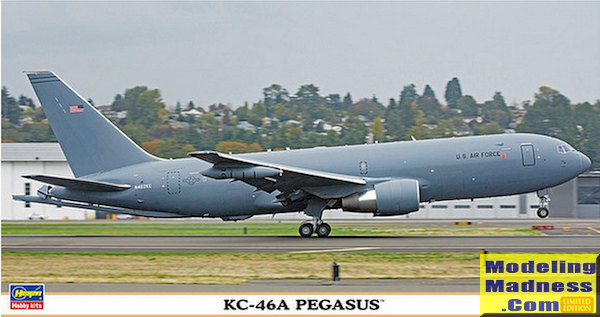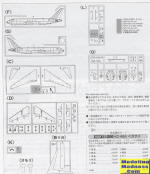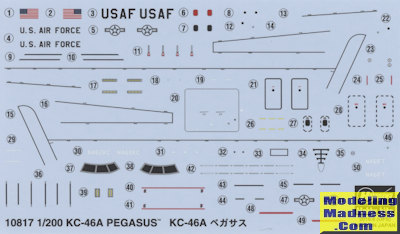
Hasegawa 1/200 KC-46A Pegasus
| KIT #: | 10817 |
| PRICE: | 2240 yen, about $22.00) from www.hlj.com |
| DECALS: | One option |
| REVIEWER: | Scott Van Aken |
| NOTES: | Limited Edition (2016) |

| HISTORY |
WhilTheBoeing KC-46 Pegasus is a military aerial refueling and strategic military transport aircraft developed by Boeing from its 767 jet airliner. In February 2011, the tanker was selected by the United States Air Force (USAF) as the winner in the KC-X tanker competition to replace older KC-135 Stratotankers. The first 18 combat-ready aircraft are scheduled to be delivered to the U.S. Air Force by August 2017 under the terms of the development contract.
The U.S. Air Force ran a procurement program to replace around 100 of its oldest KC-135E Stratotankers, and selected Boeing's KC-767. The Boeing tanker received the KC-767A designation from the United States Department of Defense in 2002 and appeared in the 2004 edition of DoD model designation report. The Air Force decided to lease 100 KC-767 tankers from Boeing.
Despite several nations leasing military aircraft, there was criticism. US Senator John McCain and others criticized the draft leasing agreement as being wasteful and problematic. In response to the protests, the Air Force struck a compromise in November 2003, whereby it would purchase 80 KC-767 aircraft and lease 20 more. In December 2003, the Pentagon announced the project was to be frozen when an investigation of allegations of corruption led to the jailing of one of its former procurement executives who applied to work for Boeing. The Air Force's KC-767A contract was officially canceled by the DoD in January 2006.
This began a long and contentious process of procuring another tanker under the KC-X program. Both Boeing and Airbus submitted proposals with Airbus initially winning the competition. However intense lobbying by Boeing got the decision reversed and the KC-45 was then chosen. Since then there have been cost over runs and Boeing has so far paid $1.9 billion in penalties due to being unable to keep down costs and in delays. This caused the delivery of the first production aircraft to be pushed back to August 2017. The KC-46 has been marketed to three other nations so far. Both South Korea and Poland have chosen the Airbus with only Japan choosing the KC-46, in part because 767 assemblies were manufactured there.
| THE KIT |
 It has been a long time since a kit company has produced a kit of a plane before the type has officially entered service, yet this is what Hasegawa has done with this one. To be sure, the aircraft is a production KC-46A, but this is without any unit markings and still carries the civilian registration of the first plane. While you may think this is rushing things a bit, it really is not. It gives those who want a KC-46 a model of it and it allows Hasegawa to use extant sprues to develop the kit. If you recall, several other nations use similar planes converted from airliners so the boom system has already been tooled. The 767 is also a plane that has been in Hasegawa's line-up for many years. In other words, this is a simple decal change. The kit portrays the first KC-46A, EMD-1.
It has been a long time since a kit company has produced a kit of a plane before the type has officially entered service, yet this is what Hasegawa has done with this one. To be sure, the aircraft is a production KC-46A, but this is without any unit markings and still carries the civilian registration of the first plane. While you may think this is rushing things a bit, it really is not. It gives those who want a KC-46 a model of it and it allows Hasegawa to use extant sprues to develop the kit. If you recall, several other nations use similar planes converted from airliners so the boom system has already been tooled. The 767 is also a plane that has been in Hasegawa's line-up for many years. In other words, this is a simple decal change. The kit portrays the first KC-46A, EMD-1.
Hasegawa was foremost in touting 1/200 scale for airliners and similar large aircraft and has produced quite a few kits in this scale. This is basically their 767-200 with additional sprues to allow you to do the tanker version. I would not be surprised to see a KC-46A boxing when that plane starts rolling off the assembly lines and into active unit inventory.
Hasegawa has produced basically two series of airliners. The initial series was raised panel lines as was vogue during that time. Those kits came with large screws to use for nose weight and could only be built out of the box with the wheels down. They also had window openings molded into the fuselage. The fuselages were split vertically.
The latest airliner kits or their second generation kits, have horizontally split fuselages and have additional gear door pieces so the planes can be built gear up. They also take advantage of slide molding and the engines are generally cast in a single piece, making the hassle of filling lip seams a thing of the past.
This kit is a first generation kit though modified. It basically improves on the first generation moldings by having engraved panel lines and smooth sides for the fuselage, relying on decals for the windows. It still has multi-piece engines, vertically split fuselage, raised panel lines on the wings, tailplanes and engines, and is not molded so that one can have it in flight without resorting to some work. It also comes with two large screws for nose weight.
In addition to the standard airliner bits, Hasegawa has included the flying boom as well as wingtip pods. There are also a lot of additional antennas for the fuselage which are not carried by the airliner. While the cockpit windows are clear, you are also provided with decals to fit over that area if you so desire. The builder will need to fill in some panel lines as these planes have cargo doors that will need to be added (decals are provided for those doors).
 Instructions are standard Hasegawa with Gunze paint references. The single marking option is for the initial test aircraft as shown on the box art. The decals do include the wing walkway areas, which is nice. These planes are painted in the standard USAF transport scheme of overall AMC grey, though the instructions call for gunship grey. This is probably too dark so look for the lighter shade. Model Master makes it. For those seeking aftermarket, this may take a bit as the first planes are not set to be delivered to the first unit at McConnell AFB until August of 2017.
Instructions are standard Hasegawa with Gunze paint references. The single marking option is for the initial test aircraft as shown on the box art. The decals do include the wing walkway areas, which is nice. These planes are painted in the standard USAF transport scheme of overall AMC grey, though the instructions call for gunship grey. This is probably too dark so look for the lighter shade. Model Master makes it. For those seeking aftermarket, this may take a bit as the first planes are not set to be delivered to the first unit at McConnell AFB until August of 2017.
| CONCLUSIONS |
Those who really want a model of the next generation USAF tanker will be sure to pick this one up. It will make into a very nice model and will not be difficult to build. I do wish that Hasegawa had done some one-piece slide-molded engines, but I can understand why they chose to leave it as it was. The aftermarket airliner folks will have replacements if you so desire.
| REFERENCES |
https://en.wikipedia.org/wiki/Boeing_KC-46_Pegasus
August 2016
Copyright ModelingMadness.com Thanks to www.hlj.com for the preview kit. You can find this kit at this link. If you would like your product reviewed fairly and fairly quickly, please contactthe editor or see other details in the